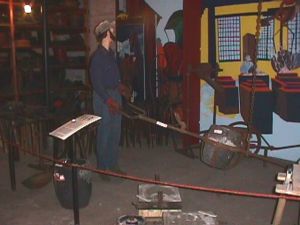| Foundry - Casting Metal Products Casting in a SAND MOLD, the foundryman uses a pre-existing pattern. The
patter is placed in a FLASK or box. A PARTING compound is dusted on the pattern and RAMMED
into the flask and around the pattern. A bottom board is placed on the flask, then rolled
over to expose the DRAG (the bottom ofthe flask). The COPE (top of the flask), is placed
on the pattern and then rammed. The cope is lifted and the pattern is drawn from the sand.
A GATING system is cut into the sand to allow the metal to flow into the cavity left by
the pattern. The mold is then closed and ready to receive the molten metal.

If copper is the metal being used it is melted in a gas fired
CRUCIBLE FURNACE. The CRUCIBLE, or melting pot, is placed in the furnace and filled with
copper. The furnace is FIRED. When the metal is molten and ready to be poured the curcible
is lifted from the furnace and placed in the POURING SHANK. The molten copper, at this
point, is about 2100 degrees Fahrenheit. It is poured into the mold and allowed to cool
and the SHAKEN out. The casting is cleaned and the GATES cut off. It is then sandblasted
and ready to be machined.
Although the C & H Foundry was a very large operation,
the same basic process was used in the casting of metals. The work of the foundrymen, but
one of the integral parts of the COPPER MINING INDUSTRY.
Online Exhibits:
Annie Clemenc
Two Man Drill
Foundry - Casting Metal Products
The Hospital
Sheffield Pump Car
Loading Ore Cars
|